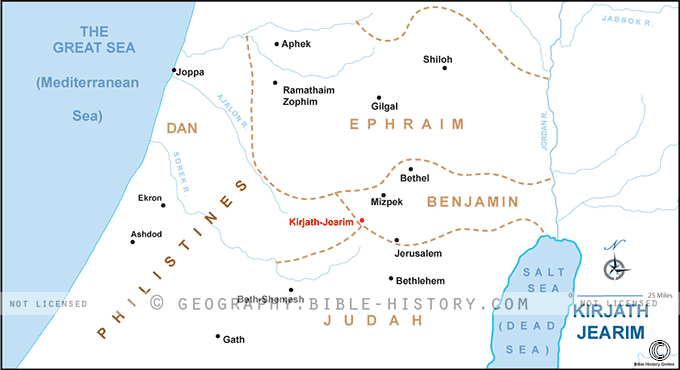
The map of Kirjath Jearim offers a compelling visual representation of a significant ancient city, often mentioned in the Old Testament of the Bible. Kirjath Jearim, also known as Kiriath Yearim or Baalah, held both historical and religious importance in the region.
Geographical Context:
The map of Kirjath Jearim showcases the city's location within the central hill country of ancient Canaan. Situated west of Jerusalem, it occupies a position that overlooks the fertile valleys and plains of the region.
City of Kirjath Jearim:
The map prominently highlights the ancient city of Kirjath Jearim itself. It was known for its strategic location, perched on a hill, and its role as a regional center for trade, culture, and governance.
The Ark of the Covenant:
Kirjath Jearim is perhaps most famous for its connection to the Ark of the Covenant, which had been captured by the Philistines and later returned to Israel. The map may feature the specific location or shrine where the Ark was kept in Kirjath Jearim before its eventual transfer to Jerusalem.
Religious Significance:
This map offers a visual window into the religious significance of Kirjath Jearim. The Ark's presence in the city symbolized the divine covenant between God and the Israelites and played a central role in their faith and worship.
Cultural and Historical Insights:
Exploring the map provides viewers with insights into the daily life, customs, and governance of the people who lived in Kirjath Jearim during biblical times. It allows for a deeper understanding of the cultural and historical dynamics of the region.
Archaeological Context:
The map also points to the archaeological significance of Kirjath Jearim, where excavations have yielded artifacts and insights into the ancient city's history and the events associated with the Ark of the Covenant.
The map of Kirjath Jearim invites viewers to step into a city that played a crucial role in the religious and cultural life of ancient Israel. It allows them to explore the city's geography, history, and religious significance, providing a rich context for understanding the events and stories that unfolded in this iconic location.